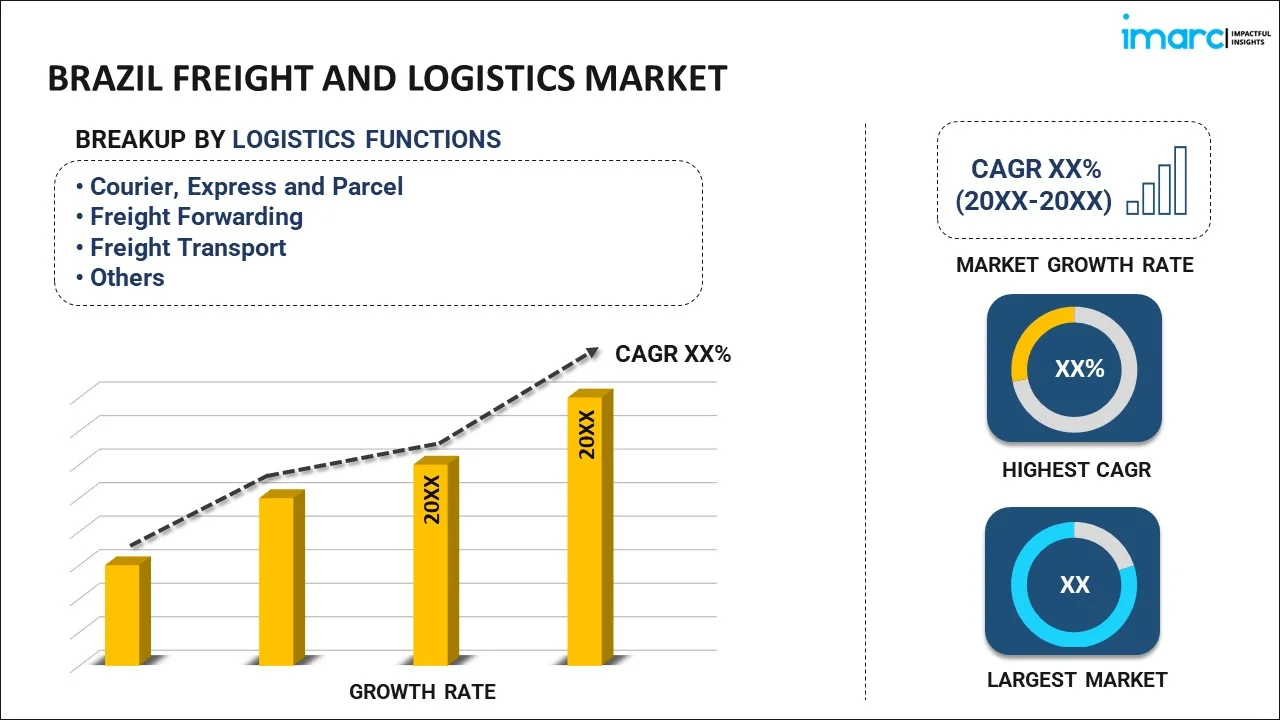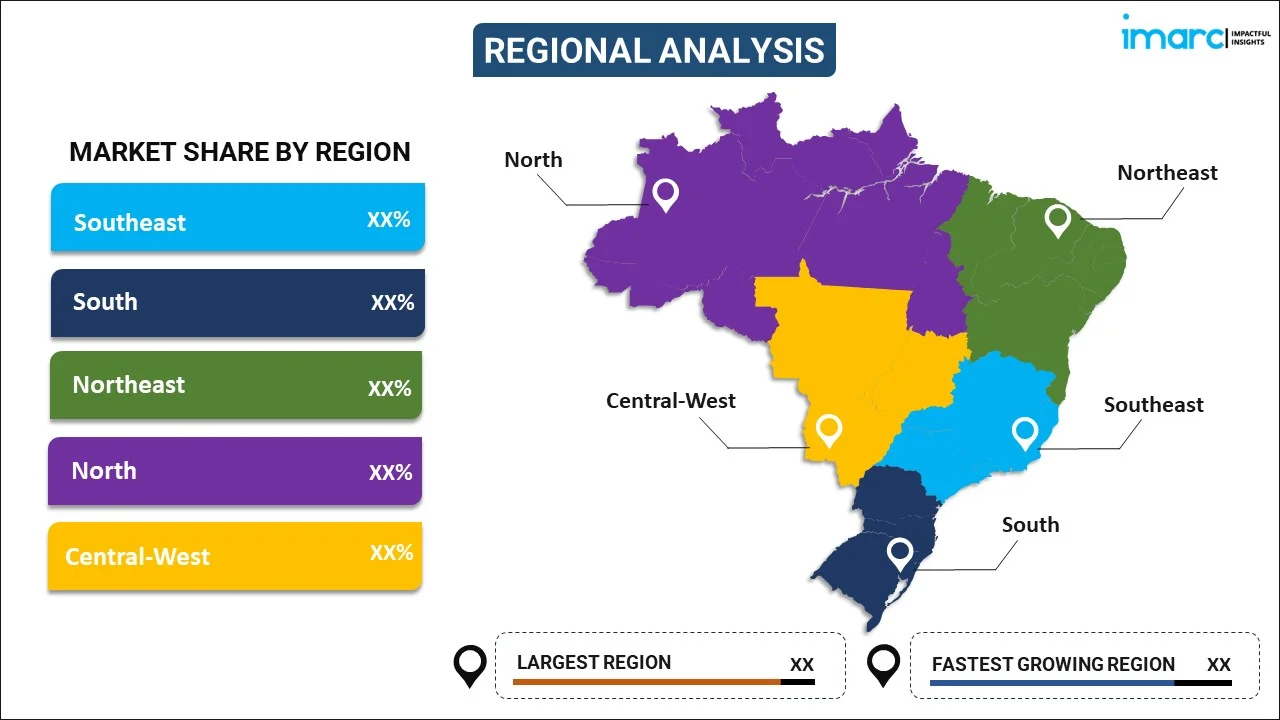
Brazil Freight and Logistics Market Report by Logistics Function (Courier, Express and Parcel, Freight Forwarding, Freight Transport, Warehousing and Storage, and Others), End Use Industry (Agriculture, Fishing and Forestry, Construction, Manufacturing, Oil and Gas, Mining and Quarrying, Wholesale and Retail Trade, and Others), and Region 2025-2033
Market Overview:
Brazil freight and logistics market size reached USD 105.4 Billion in 2024. Looking forward, IMARC Group expects the market to reach USD 143.7 Billion by 2033, exhibiting a growth rate (CAGR) of 4.60% during 2025-2033. The growing demand for faster, more convenient, and transparent deliveries, increasing number of domestic and international trade activities, and rising adoption of eco-friendly transportation systems, such as electric and hybrid vehicles, represent some of the key factors driving the market.
|
Report Attribute
|
Key Statistics
|
|---|---|
|
Base Year
|
2024
|
|
Forecast Years
|
2025-2033
|
|
Historical Years
|
2019-2024
|
|
Market Size in 2024
|
USD 105.4 Billion |
|
Market Forecast in 2033
|
USD 143.7 Billion |
| Market Growth Rate 2025-2033 | 4.60% |
Freight and logistics comprise the movement, storage, and management of goods and materials throughout the supply chain. It involves the coordination of transportation, warehousing, distribution, and inventory management to ensure the efficient flow of products from manufacturers to consumers. It relies on a diverse range of services, such as shipping, trucking, air freight, and warehousing, to meet the demands of a diverse economy. It ensures the timely and reliable delivery of goods, which is essential for businesses to maintain a competitive edge in the market. It helps in optimizing inventory levels and allows companies to reduce carrying costs and avoid stockouts or overstock situations while ensuring products are available when needed. It ensures that products reach customers on schedule to enhance their trust and satisfaction. It provides real-time tracking and visibility into the supply chain and allows businesses to monitor shipments, predict delays, and make informed decisions. It enables companies to reduce their carbon footprint by using eco-friendly transportation methods and optimizing routes to minimize fuel consumption. As it lowers the impact of unforeseen challenges on supply chains and allows firms to focus on their core competencies, the demand for freight and logistics is rising in Brazil.
Brazil Freight and Logistics Market Trends:
At present, the increasing adoption of freight and logistics, as it helps businesses navigate complex compliance issues and reduce the risk of penalties and delays, represents one of the major factors influencing the market positively in the country. In addition, the rising number of domestic and international trade activities in Brazil is bolstering the market growth. Apart from this, the growing demand for freight and logistics due to the thriving e-commerce sector in the country is offering a favorable market outlook. Additionally, the rising adoption of eco-friendly transportation systems, such as electric and hybrid vehicles, that reduce the amount of carbon in the environment is offering lucrative growth opportunities to industry investors in Brazil. In line with this, the integration of digital technologies, such as the Internet of Things (IoT) and blockchain in freight and logistics, to enhance visibility and transparency in the supply chain for more efficient operations and improved customer experiences is contributing to the market growth. Besides this, there is a rise in the demand for faster, more convenient, and transparent deliveries among individuals. This, coupled with the increasing number of transportation infrastructures, such as ports, airports, and highways, that enhance logistics capabilities and facilitate smoother movement of goods, is impelling the market growth in the country. Moreover, the rising focus on advanced supply chains that withstand disruptions is strengthening the market growth in Brazil.
Brazil Freight and Logistics Market Segmentation:
IMARC Group provides an analysis of the key trends in each segment of the market, along with forecasts at the country level for 2025-2033. Our report has categorized the market based on logistics function and end use industry.
Logistics Function Insights:

- Courier, Express and Parcel
- Destination Type
- Domestic
- International
- Destination Type
- Freight Forwarding
- Mode of Transport
- Air
- Sea and Inland Waterways
- Others
- Mode of Transport
- Freight Transport
- Mode of Transport
- Air
- Pipelines
- Rail
- Road
- Sea and Inland Waterways
- Mode of Transport
- Warehousing and Storage
- Temperature Control
- Non-Temperature Controlled
- Temperature Controlled
- Temperature Control
- Others
The report has provided a detailed breakup and analysis of the market based on the logistics function. This includes courier, express and parcel [destination type (domestic and international)], freight forwarding [mode of transport (air, sea and inland waterways, and others)], freight transport [mode of transport (air, pipelines, rail, road, sea and inland waterways)], warehousing and storage [temperature control (non-temperature controlled and temperature controlled)], and others.
End Use Industry Insights:
- Agriculture, Fishing and Forestry
- Construction
- Manufacturing
- Oil and Gas, Mining and Quarrying
- Wholesale and Retail Trade
- Others
A detailed breakup and analysis of the market based on the end use industry have also been provided in the report. This includes agriculture, fishing and forestry, construction, manufacturing, oil and gas, mining and quarrying, wholesale and retail trade, and others.
Regional Insights:

- Southeast
- South
- Northeast
- North
- Central-West
The report has also provided a comprehensive analysis of all the major regional markets, which include Southeast, South, Northeast, North, and Central-West.
Competitive Landscape:
The market research report has also provided a comprehensive analysis of the competitive landscape in the market. Competitive analysis such as market structure, key player positioning, top winning strategies, competitive dashboard, and company evaluation quadrant has been covered in the report. Also, detailed profiles of all major companies have been provided.
Brazil Freight and Logistics Market Report Coverage:
| Report Features | Details |
|---|---|
| Base Year of the Analysis | 2024 |
| Historical Period | 2019-2024 |
| Forecast Period | 2025-2033 |
| Units | Billion USD |
| Scope of the Report | Exploration of Historical Trends and Market Outlook, Industry Catalysts and Challenges, Segment-Wise Historical and Future Market Assessment:
|
| Logistics Functions Covered |
|
| End Use Industries Covered | Agriculture, Fishing and Forestry, Construction, Manufacturing, Oil and Gas, Mining and Quarrying, Wholesale and Retail Trade, Others |
| Regions Covered | Southeast, South, Northeast, North, Central-West |
| Customization Scope | 10% Free Customization |
| Post-Sale Analyst Support | 10-12 Weeks |
| Delivery Format | PDF and Excel through Email (We can also provide the editable version of the report in PPT/Word format on special request) |
Key Questions Answered in This Report:
- How has the Brazil freight and logistics market performed so far and how will it perform in the coming years?
- What has been the impact of COVID-19 on the Brazil freight and logistics market?
- What is the breakup of the Brazil freight and logistics market on the basis of logistics function?
- What is the breakup of the Brazil freight and logistics market on the basis of end use industry?
- What are the various stages in the value chain of the Brazil freight and logistics market?
- What are the key driving factors and challenges in the Brazil freight and logistics?
- What is the structure of the Brazil freight and logistics market and who are the key players?
- What is the degree of competition in the Brazil freight and logistics market?
Key Benefits for Stakeholders:
- IMARC’s industry report offers a comprehensive quantitative analysis of various market segments, historical and current market trends, market forecasts, and dynamics of the Brazil freight and logistics market from 2019-2033.
- The research report provides the latest information on the market drivers, challenges, and opportunities in the Brazil freight and logistics market.
- Porter's five forces analysis assist stakeholders in assessing the impact of new entrants, competitive rivalry, supplier power, buyer power, and the threat of substitution. It helps stakeholders to analyze the level of competition within the Brazil freight and logistics industry and its attractiveness.
- Competitive landscape allows stakeholders to understand their competitive environment and provides an insight into the current positions of key players in the market.
Need more help?
- Speak to our experienced analysts for insights on the current market scenarios.
- Include additional segments and countries to customize the report as per your requirement.
- Gain an unparalleled competitive advantage in your domain by understanding how to utilize the report and positively impacting your operations and revenue.
- For further assistance, please connect with our analysts.

 Inquire Before Buying
Inquire Before Buying
 Speak to an Analyst
Speak to an Analyst
 Request Brochure
Request Brochure
 Request Customization
Request Customization



.webp)




.webp)












